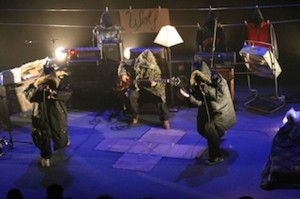Inspiring and intelligent Toronto theatre in La Fugue
La Fugue is a powerful piece of theatre presented succinctly in forty-five minutes. I was among an audience of high school drama students and I was enthralled by their level of engagement with the performance.
La Fugue presents Yohann, a teenage boy, who runs away from his restrictive and authoritative father to find a new family among street-involved youth.
While I’m a sucker for the written and spoken word, I can’t ignore the punches La Fugue packs. The dialogue is minimal to non-existent; the production relies almost exclusively on music and puppetry to convey the story.
The show opens with the four actors walking through the aisles and calling out Yohann’s name. There is a musical transition that is loud and electric and sets the tone for the rest of the show.
The actors are also musicians and there is a full band on stage that plays live music in the hard rock, industrial, and hip hop veins. The music is loud, aggressive and angry. It is a great representation of the inner landscape of a young man at odds with his environment.
La Fugue touches on domestic dysfunction, teen homelessness, drugs, gangs and gang violence, rape and transformation.
This isn’t the kind of show you would bring your grandma to.
The set is busy and chaotic. There is a drum kit, a desk with a cityscape chalked on, a leather chair, and a sleeping bag. There is a clothesline that is used to introduce characters and musical pieces.
Puppets contribute to the fantasy of what this young man’s journey is. The actors create the puppets out of clothing. Yohann is created from a hoodie and his friend Noémie is created using a bomber jacket and purse. The gang is almost as faceless as Yohann and Noémie but their bodies are large in the snorkel parkas they wear.
The story seems to be told from the point of view of Yohann’s father, the only character played by an actor and not a puppet. Papa receives a box from the police and pieces together the story of his missing son. The effect of the ghostlike puppets creates a distance that enables the exploration of the important issues in the performance.
With lack of focus on words, the audience is free to interpret the story and its outcome as they see it. The creators of the play are careful to include layers of meaning for the audience to interpret for themselves. La Fugue is not pedantic. It inspires conversation and plays to the top of its audience’s intelligence.
Overall, this play knows when to push and when to pull back. Its success lies in its ability to incorporate a range of artistic media while trusting in its audience’s theatrical literacy.
Details
- La Fugue (SMCQ Jeunesse/Qui Va Là/Young People’s Theatre) is playing at Young People’s Theatre (165 Front Street East) until May 16, 2013
- Recommended for ages 13 & up
- Performances are at 10:30 am and 1pm
- Tickets: $15-$20
- Tickets can be purchased online or by calling the box office at 416-862-2222
Photo of Félix Beaulieu-Duchesneau, Justin Laramée and Philippe Racine by Jacques Cabana

